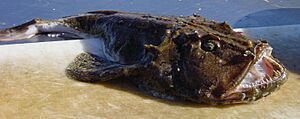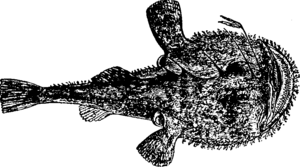Angler facts for kids
Quick facts for kids Angler |
|
|---|---|
 |
|
| Conservation status | |
| Scientific classification | |
| Genus: |
Lophius
|
| Species: |
piscatorius
|
 |
|
| Synonyms | |
|
|
The Lophius piscatorius, also known as the angler or common monkfish, is a fascinating fish. It belongs to the monkfish family called Lophiidae. You can find this unique creature in the coastal waters of the northeast Atlantic Ocean. Its home ranges from the Barents Sea all the way to the Strait of Gibraltar. It also lives in the Mediterranean Sea and the Black Sea. In some areas, like the Irish Sea, this fish is important for fishing.
Contents
About the Anglerfish Name
The scientific name for this fish is Lophius piscatorius. The famous scientist Carl Linnaeus first described it in 1758. He named it based on where it was found in Europe.
What the Name Means
The name Lophius comes from a word meaning "mane." This likely refers to the tentacle-like spines on its back. The second part, piscatorius, means "of fishing." This is a perfect name for this fish! It has a special "fishing rod" on its head. This rod is called an illicium. It has a lure, or "esca," at the end. The anglerfish uses this lure to attract its prey.
Anglerfish Appearance
European anglerfish usually grow to be about 40 to 60 centimeters (16 to 24 inches) long. Some can even be much bigger! Fish living in deeper waters tend to be larger than those in shallow areas.
Its Unique Head and Mouth
This fish has a very large, flat, and wide head. The rest of its body seems small compared to its head. Its mouth is huge and goes all the way around the front of its head. Both its upper and lower jaws have many long, pointed teeth. These teeth point inwards. This design helps the fish swallow its prey easily. It also stops the prey from escaping.
Fins and Camouflage
The anglerfish's pectoral and pelvic fins work like feet. This allows the fish to "walk" along the seafloor. It often hides in the sand or among seaweed. Its skin has frilly parts around its head and body. These look like small pieces of seaweed. The fish can also change its body color to match its surroundings. This amazing ability helps it blend in perfectly. It has no scales.
Reproduction
Female anglerfish have two long, ribbon-like ovaries. These ovaries swell up with eggs during the breeding season. The eggs are surrounded by a jelly-like substance. Male anglerfish have bean-shaped testes.
Anglerfish Home
The European anglerfish lives on muddy and sandy bottoms. It can be found at depths of up to 1,000 meters (3,300 feet). Sometimes, it also lives on rocky bottoms. They rarely go deeper than the continental slope.
Anglerfish Behaviour
How Anglerfish Hunt
The anglerfish has long, thin parts on its head. These are actually changed spines from its first dorsal fin. The most important one is the first spine. It is the longest and has a lure at its tip. This lure can move in any direction. The anglerfish uses this lure to attract other fish. When a smaller fish comes close, the anglerfish quickly opens its huge jaws and swallows it. Its stomach can stretch a lot. It can even swallow prey that is as big as itself!
Adult anglerfish mostly eat other fish. Younger anglerfish, called juveniles, mainly eat small sea creatures without backbones. In northern Europe, Norway pout is a common meal. In southern areas, blue whiting is more popular. They also eat whiting and Norway lobster. Sometimes, they even catch Lesser sandeel or cephalopods like squid. In one unusual case, an anglerfish was found with a herring gull in its stomach! They are known to come to the surface to try and catch waterbirds.
Breeding and Life Cycle
Anglerfish eggs are released in a thin, clear, jelly-like sheet. This sheet can be 60 to 90 centimeters (2 to 3 feet) wide. It can be 7.5 to 9 meters (25 to 30 feet) long. The eggs are in a single layer, each in its own small space. This sheet floats freely near the water's surface. Wind and currents help spread the eggs. A single female can release between 300,000 and 2,800,000 eggs!
Young anglerfish, called larvae, swim freely. Their pelvic fins grow into long filaments. Male anglerfish become adults at four years old, when they are about 40 centimeters (16 inches) long. Female anglerfish take two years longer to mature.
The main time for anglerfish to lay eggs is from February to June, especially in spring. They also have a smaller spawning season in November and December.
Anglerfish and People
Lophius piscatorius has always been a valuable fish caught by accident in Atlantic fisheries. As deep-water fishing technology improved, more and more anglerfish were caught. Since the 1980s, this species has become an important fish for commercial fishing in areas like Spain and Portugal. Another similar species, Lophius budegassa, is often caught with it. However, L. piscatorius is usually found in larger numbers.




